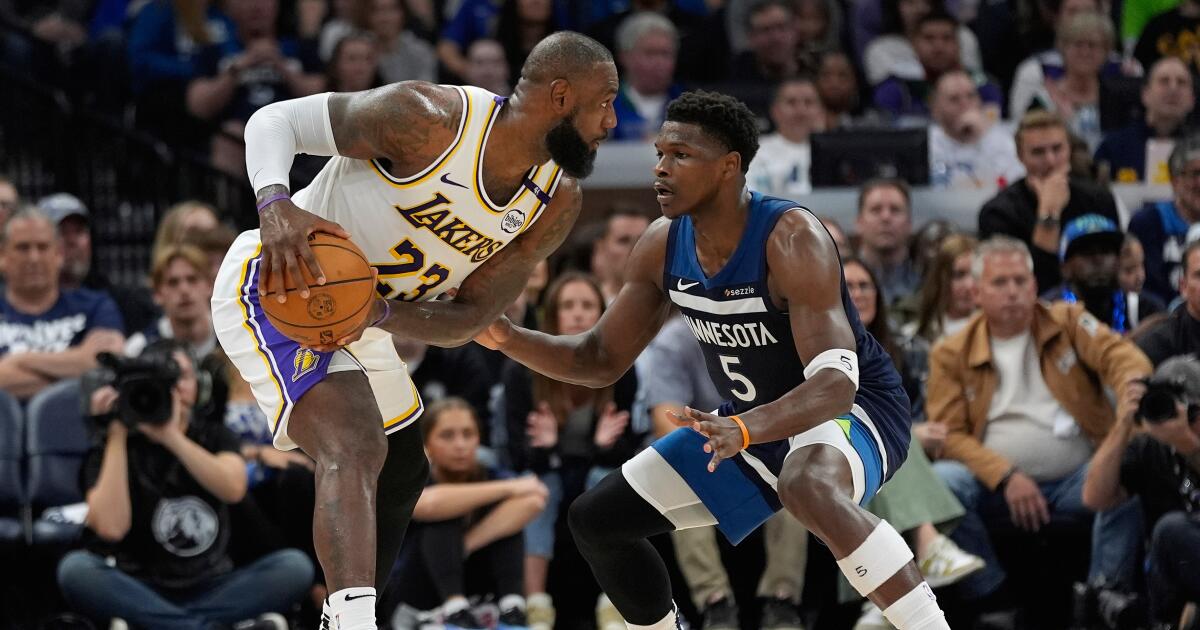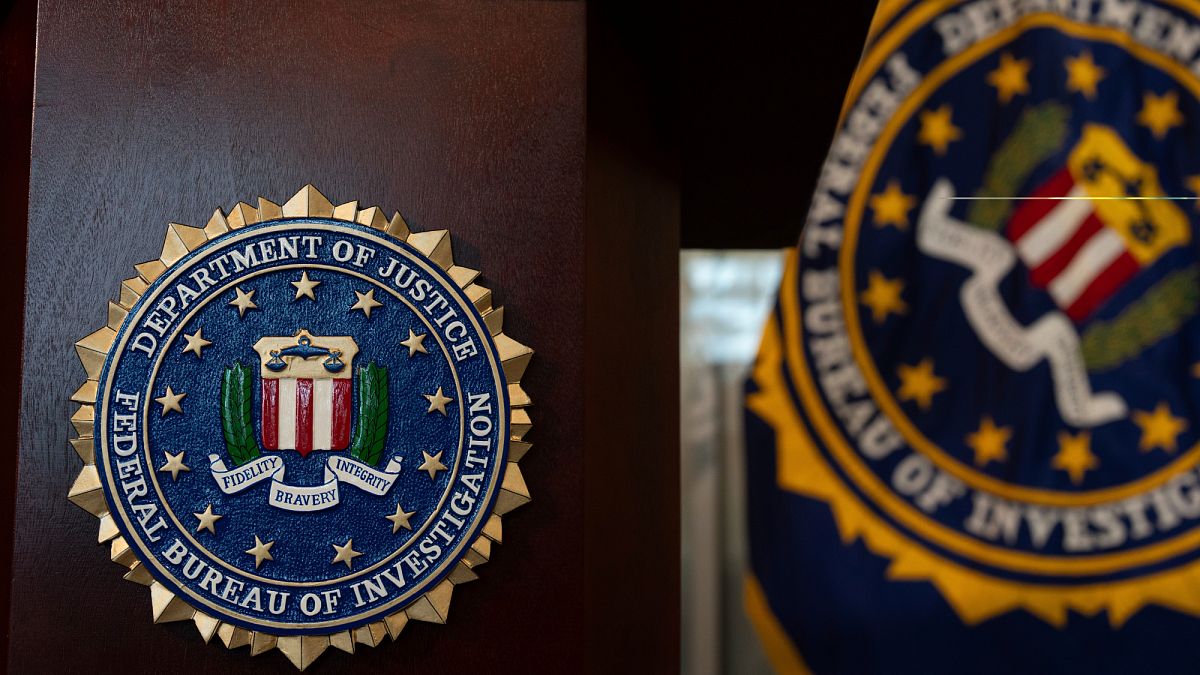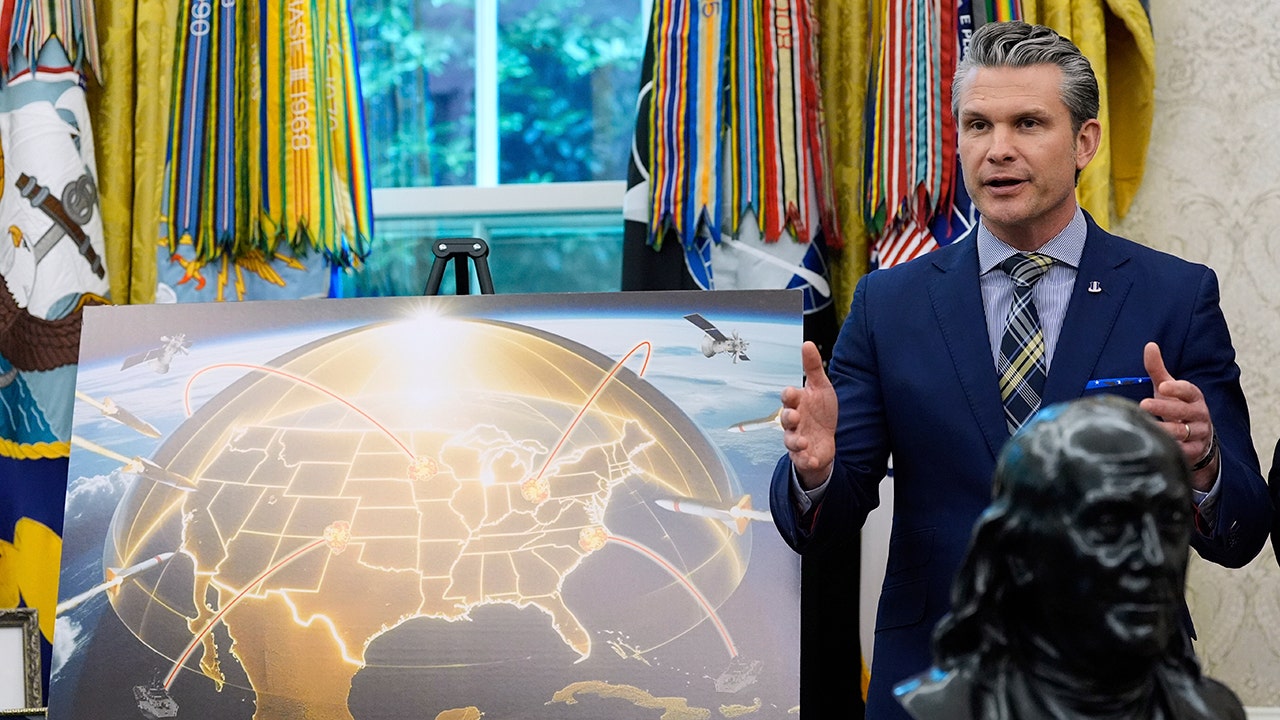Lifestyle
Megan Fox and MGK Super Affectionate, Seemingly Back Together After Breakup Rumors
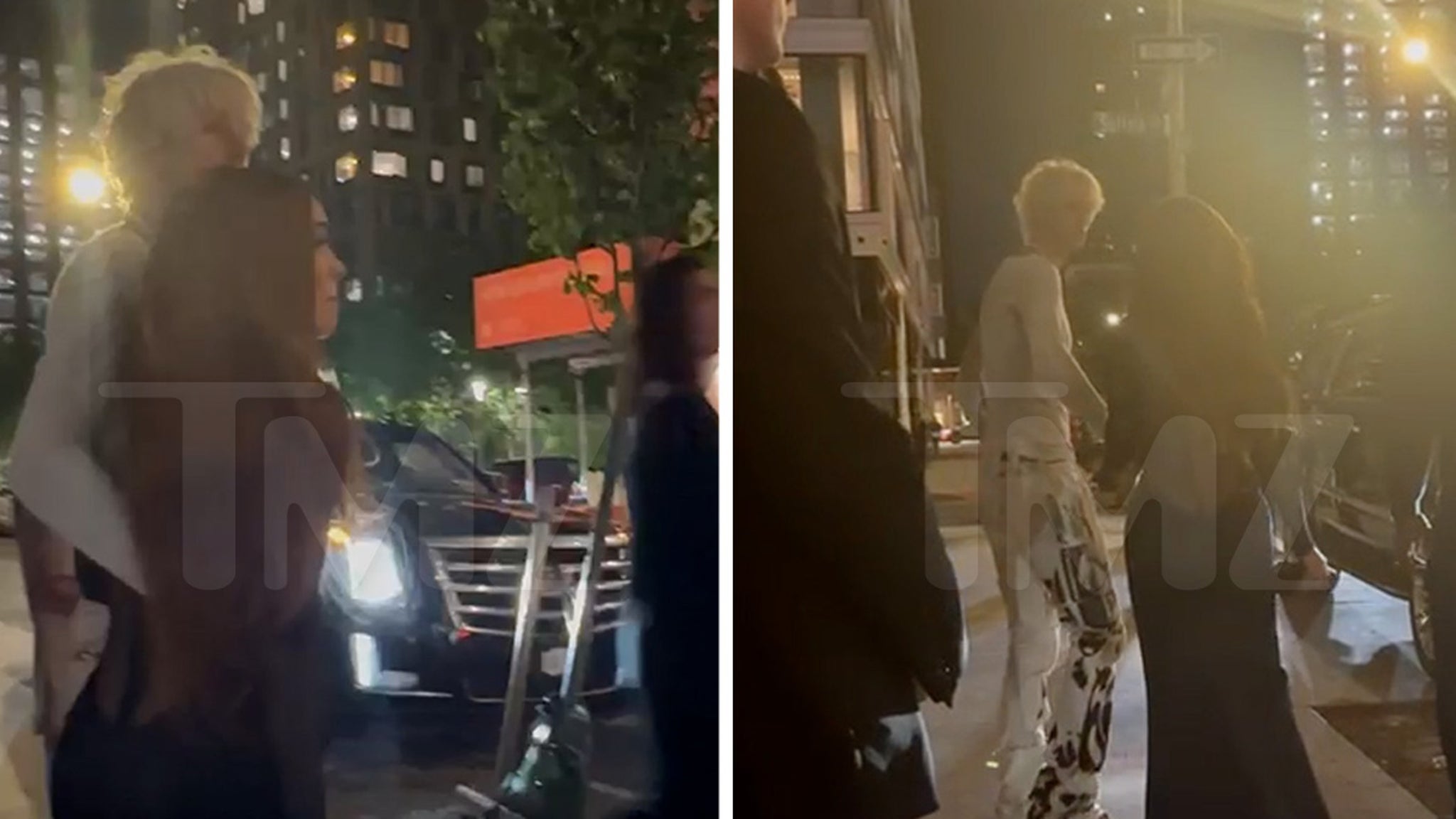
TMZ.com
Megan Fox and Machine Gun Kelly buried any rumors of a possible split Thursday night … the couple was spotted all over Manhattan — and all over each other.
Check out this video, obtained by TMZ, which shows Megan and MGK standing side by side in front of Skylight Essex Crossing, where they had just left a party hosted by Blink-182 drummer Travis Barker and his wife, Kourtney Kardashian.
MGK has his arm wrapped around Megan as he massages her back. The two also hold hands as they mosey down the block.
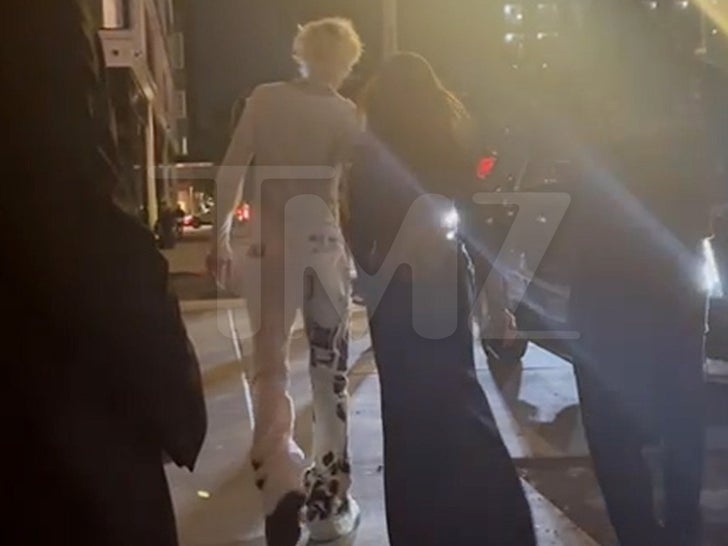
We’re told MGK and Megan were “super affectionate” and couldn’t keep their paws off one another. MGK was kissing Megan, putting to bed claims their relationship was in trouble.
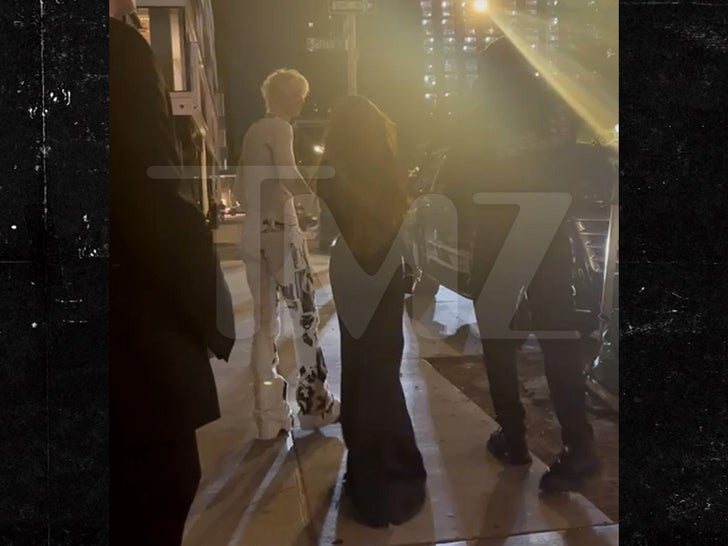
As you recall, Megan first hinted at a breakup with MGK in February when she posted on social media lyrics from Beyonce‘s “Lemonade” album, alluding to infidelity. Fans took that to mean the couple had gone their separate ways. Some even speculated that MGK had an affair with his band’s guitarist, Sophie Lloyd. Sophie’s reps vehemently denied it.
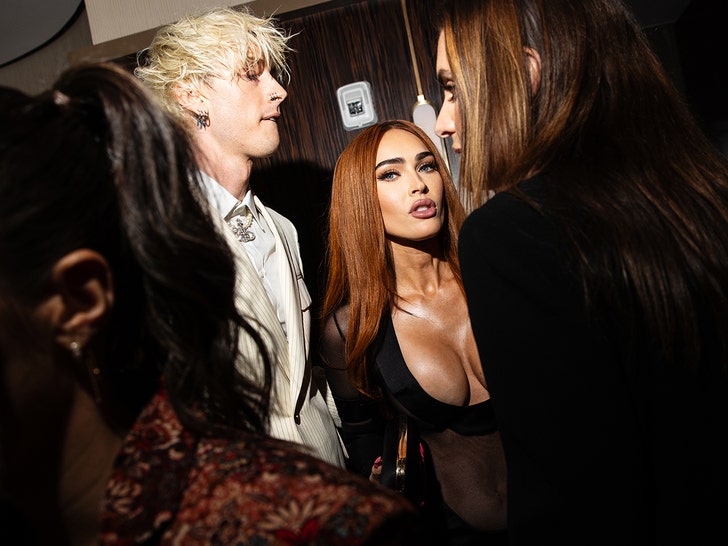
But now it seems everything is back on track for Megan and MGK. On top of Travis’ shindig, the lovebirds hit the red carpet at the Sports Illustrated Swimsuit Issue release party Thursday night in NYC. Megan is one of the models featured in the issue.

The pair started dating in 2020 after meeting on the movie set of “Midnight in the Switchgrass.”

Lifestyle
After 103 years, this L.A. prop maker finds new success freeze-drying dead pets

In a room inside a North Hollywood warehouse, dozens of pets are ready for their owners to take them home.
Boots, a young black-and-white domestic shorthair cat, lies on his back, pawing playfully at the air. A trio of red, yellow and green parrots and cockatiels sit on wooden perches, oblivious to the piercing stare of a blue-eyed feline a few feet away. Princess, a senior Chihuahua, rests with her eyes closed and body curled into a tight cocoon, as a frenetic hamster named Ponby stands upright, his eyes bulging. There’s a naked guinea pig, a giant red macaw and an adorably chunky pit bull named Messy.
Eyes, such as those shown here on Messy the pit bull, are made of glass and closely match the animal’s original colors.
(Myung J. Chun / Los Angeles Times)
All of these animals are loose, liberated from the confines of cages and leashes, and yet no havoc has ensued.
These animals are also all dead.
It’s an everyday scene at Bischoff’s the Animal Kingdom, a Los Angeles taxidermy business that has been preserving animals for 103 years. The business is multifold — Bischoff’s creates and rents out prop animals to film studios, museums and nature centers. Posters on the lobby walls boast the company’s work on shows like “American Horror Story” and “Westworld.” But in recent years, a bulk of its taxidermy requests now come from bereaved pet owners, those willing to shell out thousands of dollars for a tangible commemoration of their late “fur babies.”

Birds are commonly preserved at Bischoff’s, but the business has made mementos of more obscure pets, including chameleons, roosters and hairless guinea pigs.
(Myung J. Chun / Los Angeles Times)
From full-body taxidermy to partial mementos — skulls, bronzed hearts or freeze-dried paws, for example — such services provide closure in ways that, clients say, traditional burials or urns cannot.
“It was honestly really comforting to have her back, and just be able to touch her and, in a sense, talk to her too,” said Bischoff’s customer Zoe Hays of the preservation of her Chihuahua-Yorkie mix Pixie. “She was a great little dog — also a menace to society, for sure — but she’s still with me, and she always will be.”
Bodily preservation, beyond the ashes or cemented paw prints offered by veterinarians and animal hospitals, has become a growing facet in the world of pet aftercare, with traditional taxidermists fulfilling many of the niche requests.
-
Share via
Inside Bischoff’s, the L.A. taxidermy company that preserves dead pets
Redlands business Precious Creature initially only offered full-body taxidermy of pets until customers started suggesting other ideas, such as lockets containing patches of fur and cat-tail necklaces. (Most recently, owner Lauren Kane sewed a zippered pillowcase using the black-and-white fur of a rescue named G-Dog, or, as his owner fondly called him, “Fluffy Butt.”) In her documentary “Furever,” filmmaker Amy Finkel explores the lengths to which pet preservationists will go, asking, “Who decides what kind of grief is acceptable, or appropriate?”

Bischoff’s co-owner Ace Alexander had a songwriting career before transitioning to taxidermy.
(Myung J. Chun / Los Angeles Times)
Ace Alexander, 40, and Rey Macias, 55, the fourth owners in Bischoff’s long history, have steered the company to meet the new demand. Describing each other as “good friends,” the two men dress similarly in unofficial uniforms of black T-shirts and black pants, and they’re so in sync they sometimes finish each other’s thoughts. Since taking over the business, both have transitioned to primarily vegan diets.
“Bischoff’s used to be taxidermists to the stars in the trophy era, but now we’re taxidermists in the pet preservation era,” Alexander said. “People no longer hunt. Now they just love their pets.”
Hollywood needs supporting actors, even if they’re stuffed
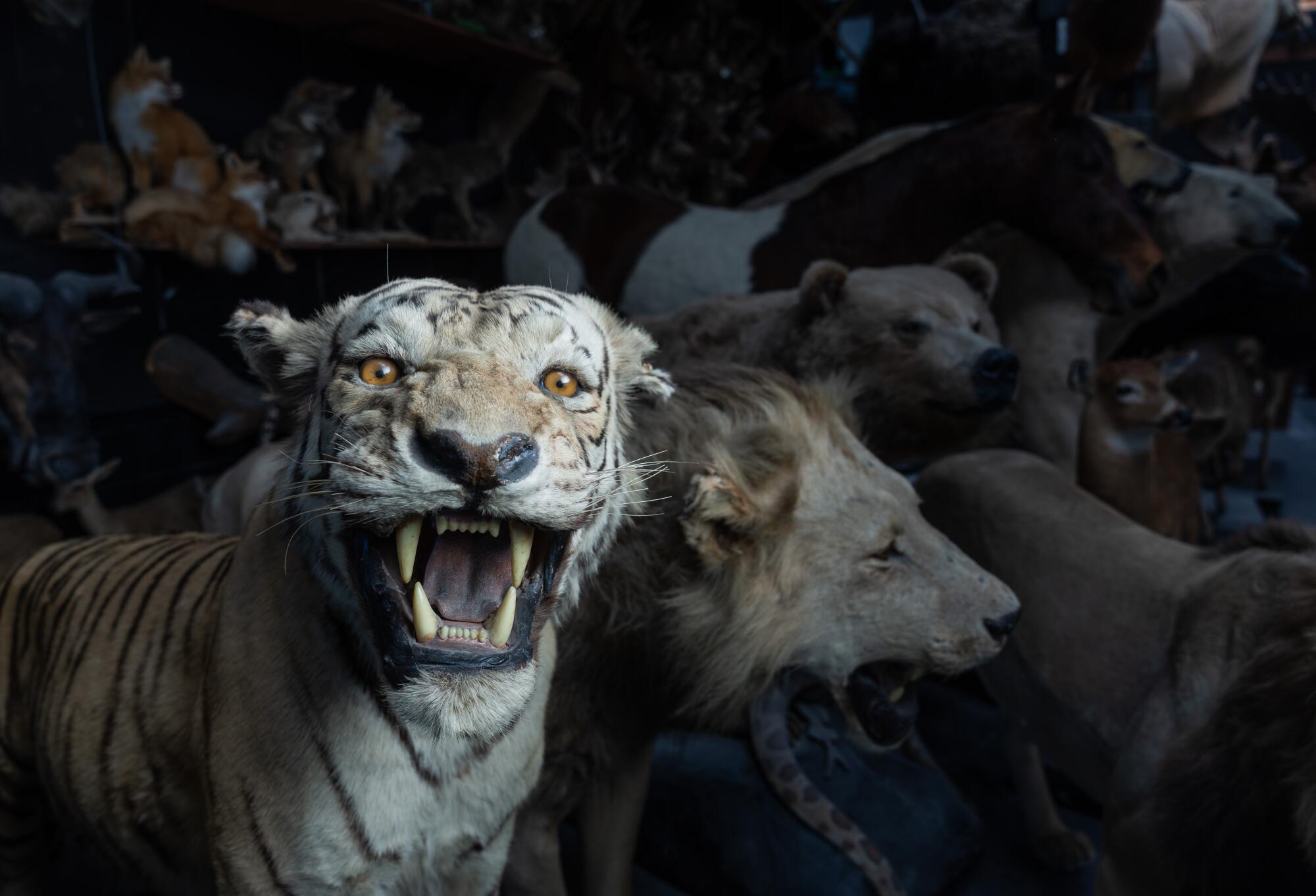
Over the decades, Bischoff’s has preserved hundreds of animals. The Sumatran tiger has made many appearances in films and TV shows, including “Snowfall,” “Palm Royale” and “Welcome to Chippendales.”
(Myung J. Chun / Los Angeles Times)
In 1922, when Al Bischoff first opened the business on Sunset Boulevard in Hollywood, he’d stuff and plaster any animal brought to him. Most of the time, that meant trophies from hunting and safari trips, but it also included beloved pets owned by Hollywood elite. Roy Rogers used Bischoff’s to preserve his co-stars Trigger the horse and Bullet the dog. Buck — the dog from “Married with Children” — also got the Bischoff’s treatment.
Under Alexander and Macias’ tutelage, that’s still the case. They’ll preserve any animal you bring them — so long as it is not a protected species or an illegal pet. They’ll even make you a unicorn or a sasquatch or a wearable Velociraptor costume that roars and can open and close its jaws. The largest animal Alexander and Macias have preserved was an 11-foot-long buffalo, while the smallest, not including insects, was a hummingbird. Off the top of their heads, the only animal they haven’t preserved — yet — is the genetically rare white tiger.

Bischoff’s owners Ace Alexander, left, and Rey Macias show off a custom order of a pink peacock (sans tail) for a film.
(Myung J. Chun / Los Angeles Times)
The majority of Bischoff’s clientele still comes from Hollywood. Due to federal and state laws, as well as industry regulators like the American Humane Association, it often makes more sense to use body doubles for animals when filming and is occasionally mandatory (such as scenes that involve roadkill or drowning incidents).
On a recent Wednesday, Alexander fielded calls from studios about the types of snake skins in stock, how to clean dirt off a rented coyote and the particular body poses of their turkeys.
“So what are you thinking?” Alexander said, talking on the phone. “Turkeys in flight? Perched? Or did you need a floppy version?”
As for the pet sector, which accounts for around 40% of their business, dogs and cats, unsurprisingly, make up the majority of the preservations, but the team has also worked on rabbits, rodents, chameleons and roosters. And although they will preserve your pet goldfish, they will strongly encourage you to consider having a synthetic version made of it due to the oils in the scales, which inevitably lead to deterioration.
Bischoff’s works on pets shipped from around the country as well as overseas. Dr. Xanya Sofra, who is based in Hong Kong, has had at least half a dozen of her papillons preserved by Bischoff’s. Another client, who was an avid hiker, had Bischoff’s preserve his golden retriever in an upright position so that he could carry it in his backpack on his treks.
Neither Alexander nor Macias had a background in taxidermy when they started working at Bischoff’s. They were both musicians, which is how they initially met. Macias also owned an auto shop and has been taking apart and fixing appliances from a young age.
Alexander picked up jobs at Bischoff’s when it was owned by the previous owner, Gary Robbins. The pay was good, the work interesting and he realized he had a knack for airbrushing and sculpting. In 2017, when Robbins was ready to retire, Alexander and Macias, who by then had also started working there, decided to buy the business.
Blending artistic skill with scientific knowledge

Each multi-level freeze-dryer can fit around a dozen pets at a time. Smaller pets need three to four months to dry out, while larger animals take nearly a year.
(Myung J. Chun / Los Angeles Times)
Bischoff’s specializes in a form of hybrid taxidermy, incorporating traditional techniques with the more new-fangled freeze-drying process. The results are not only more lifelike and long-lasting than the standard gut-and-stuff method, but it also allows for the bulk of the original animal to remain, including the skeletal structure, toenails, whiskers, eyelids, nose and teeth. The eyes, however, are made of glass.
The method leaves room for error. Water can be used to dampen and repose the body and paint can be removed or retouched.
“You can definitely backpedal,” Alexander said, making a note to check the texture of the preserved hearts on sticks in the next 24 hours.
Alexander credits this attention to detail to his predecessors, former owner Robbins and then-main taxidermist Larry Greissinger, who taught him the trade. Strict in their teachings, Robbins and Greissinger emphasized getting every bodily facet correct: from recreating the natural anatomy to sewing the perfect hidden stitch to making sure the eyes looked right.
“That’s where the emotion is,” Alexander said. “You can get the perfect body pose, but if the eyes aren’t sitting well or don’t carry any emotion, then the animal will never look alive.”
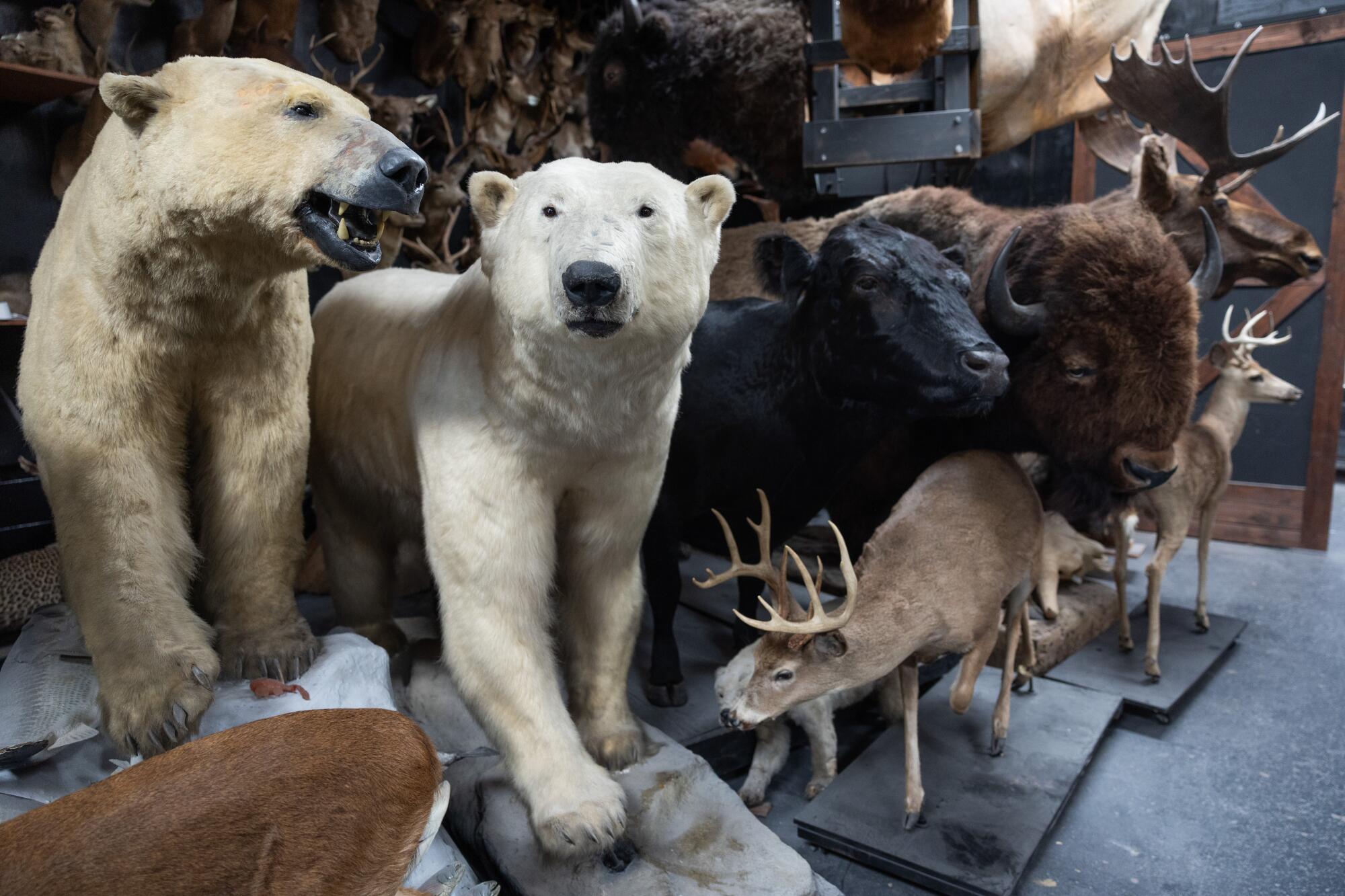
Bischoff’s has old and new taxidermy, including two polar bears from the 1940s and 1950s, a bull created in 2013 for the “Yellowstone” prequel “1923” and a buffalo that appeared in “The Lone Ranger.”
(Myung J. Chun / Los Angeles Times)
A few of Bischoff’s early taxidermy pieces are still on display, including a dog, which looks more like a cross between a wolf and a baboon, dating to the 1920s. Its plaster interior, an old taxidermy technique, gives it a stiff visage and makes it exceedingly heavy.
Bischoff’s prices reflect its modernized techniques, as well as the amount of time and attention to even the smallest of details required to make a dead pet come back to life. The cost for a fully preserved cat or a small dog like a Chihuahua starts at $2,640, with small birds, like a budgie, starting at $850.
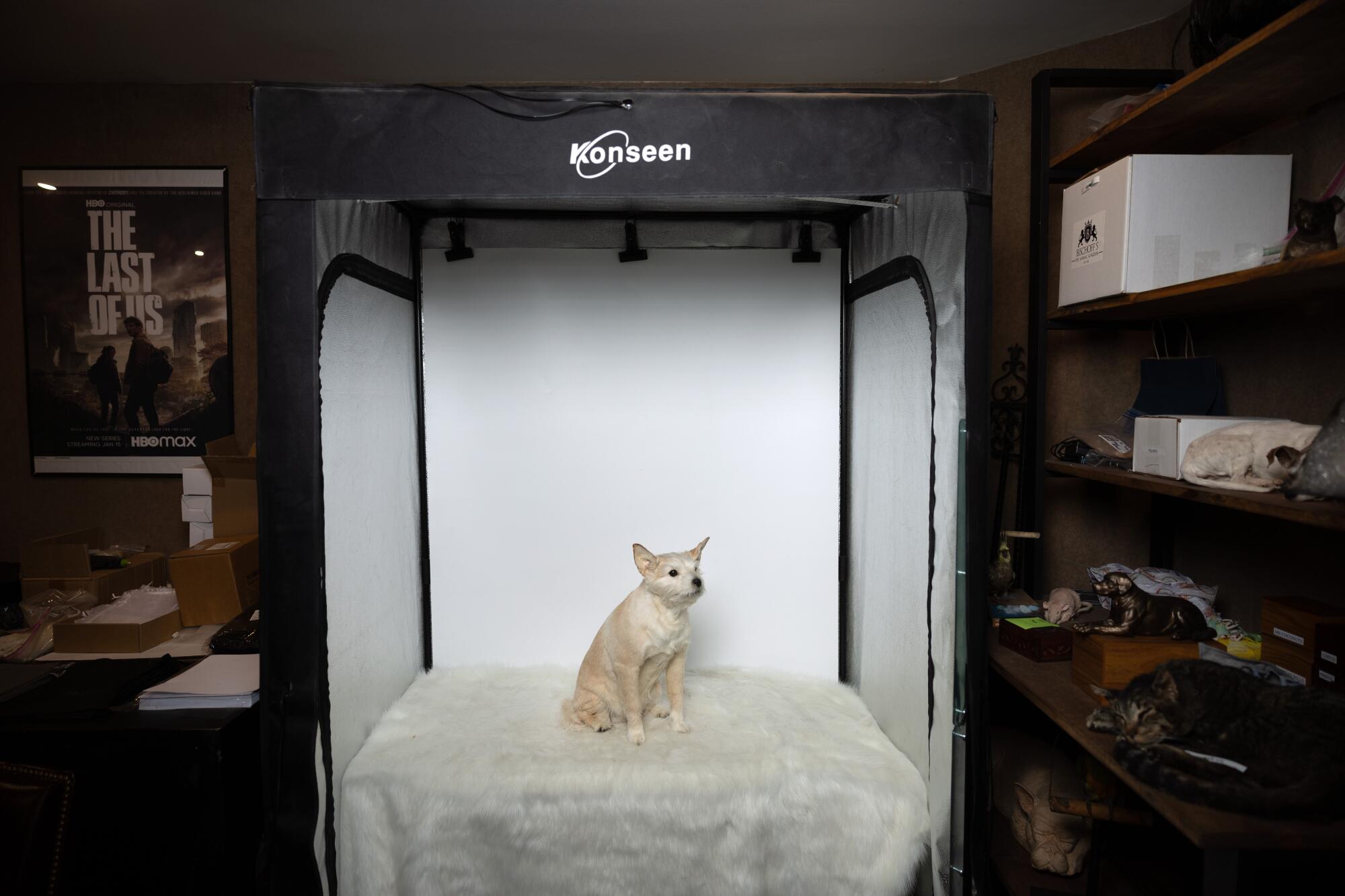
A photo booth is set up in Bischoff’s warehouse, where images of the completed pets are taken.
(Myung J. Chun / Los Angeles Times)
Although most customers order full-body taxidermy, an “a la carte” menu has expanded over the years with jars of whiskers or fur, bundles of bones tied in a bow and, the most recent addition, freeze-dried hearts, which come mounted inside of a glass cloche. Bischoff’s also offers cloning services through its Texas-based affiliate Viagen Pets, to whom they send the pet’s skin tissues.

Pelts, paws and bronzed skulls are among the smaller items purchased by pet owners.
(Myung J. Chun / Los Angeles Times)

Bischoff’s in-house artist Laischa Ramirez creates hand-drawn portraits of pets for owners who request it.
(Myung J. Chun / Los Angeles Times)
Costly though their work is, Alexander and Macias see it as an investment. Pets, they point out, are friends you look at every day. You’re intimately aware of their nuances and quirks, like how their left ear might curl back more than the right one or the way their nose tilts ever-so-subtly upwards. Entrust their preservation to a novice or lower-cost taxidermist, and you risk losing some of the elements that made your pet who they were.
Bischoff’s has seen its share of people who’ve preserved their pets with budget taxidermists only to be disappointed. “It’s unfortunate because at that point, there’s not much we can do,” Alexander said. Such pets are cremated “because they just can’t stand to look at them.”
Bischoff’s key component? Compassion
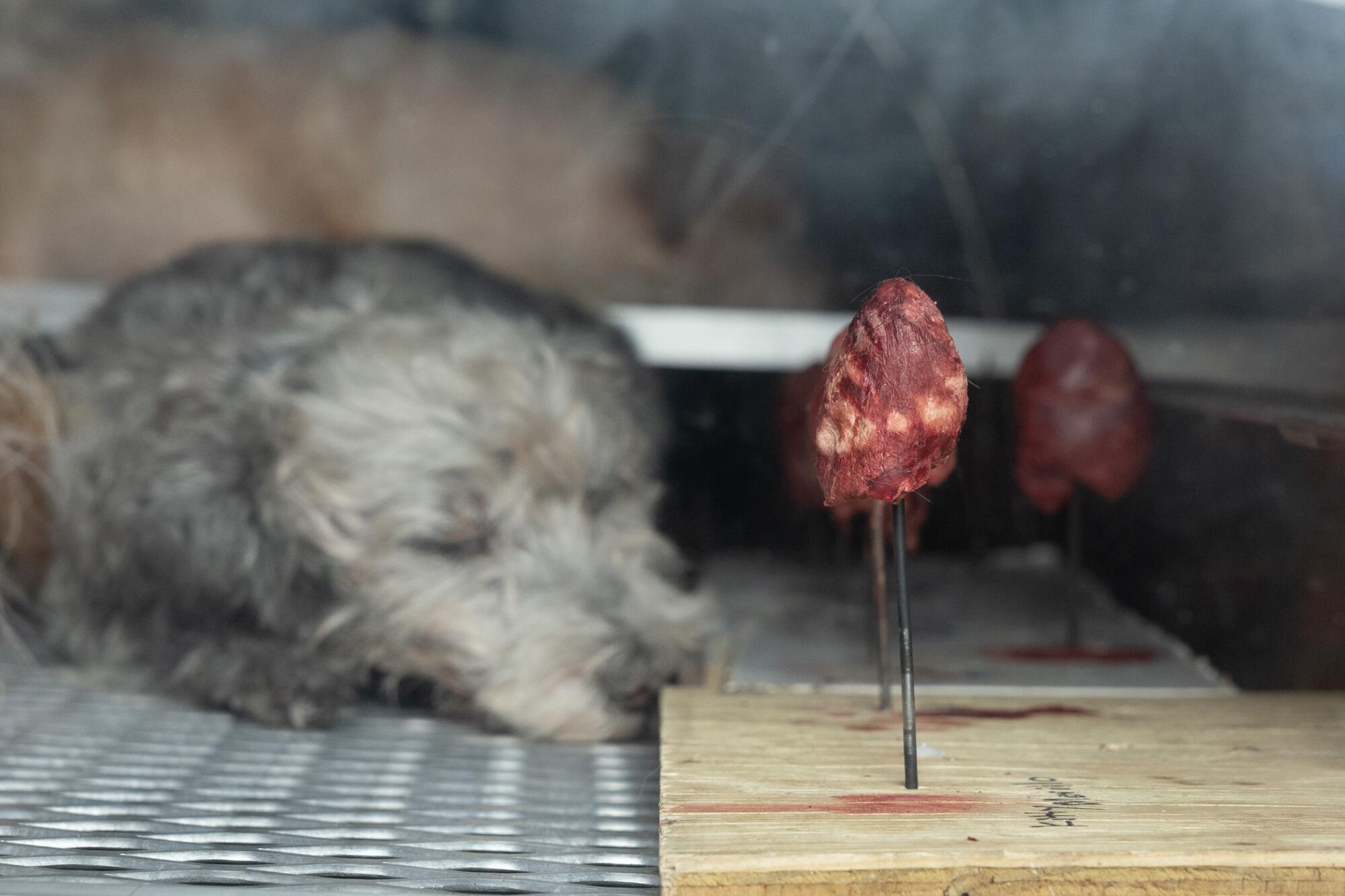
Pets and pet hearts sit in a freeze-dryer at Bischoff’s.
(Myung J. Chun / Los Angeles Times)
In the back of Bischoff’s warehouse is where the equipment resides and the smells of the oils running the machines permeates the space. The company has one aquamation machine that uses alkali solution, heat and pressure to break down the organic material into ashes. With interior chambers lined with perforated metal walls, the contraption somewhat resembles a fast-food restaurant’s deep fryer. Except, one taxidermist notes, when the process is done, instead of having golden fried potato strips in each basket, all that is left are bones.
Oftentimes at the ends of these processes, Bischoff’s workers will find inorganic remnants from the pets, such as microchips, metal plates or orthopedic screws. They give them to their owners as keepsakes.
Macias’ son, 29-year-old Chris Macias, works alongside his dad at Bischoff’s. He started helping out to make extra money while attending nursing school, but when business picked up, he decided to transition fully into the taxidermy business. He does a little bit of everything — recently, it was prepping a seal pelt for the San Pedro Marine Mammal Care Center — but tends to do pet pickups the most. Less technical though it may be, it is more emotionally taxing as he’s interfacing with grieving clients who might still be in shock or confused as to what exactly they want to do with their late pets.

Two calico cats were returned to Bischoff’s by the children of the woman who owned them after her death.
(Myung J. Chun / Los Angeles Times)
“Everybody’s different, but I just try to be there for them,” Chris said. “Their pet was part of their family, so I totally understand. Because all of us here, we have our own pets as well. We get it.”
Though Alexander never imagined building a career out of preserving dead pets, he said, “We’ve found joy in this work and we just see preservation as another form of art.”
It’s that art that is helping keep the memories of beloved pets alive — for generations even. Hays, the owner of Chihuahua-Yorkie mix Pixie, already has a contingency plan in place for Pixie’s taxidermy upon her own death. It will be “adopted” by another family member. Her daughter has already called dibs.
And many of Bischoff’s pet preservation customers are repeat clients, which is something that Alexander and Macias take pride in. Two women picking up the taxidermy body of their late cat recently chatted with Alexander about their newest rescue, a diabetic stray cat burnt in the Altadena fires. They couldn’t help but comment on the “beautiful bone structure” of the feline, still very much alive.
“I was like, ‘Hmm, you’re definitely going on the altar some day,’” one of the women said.
Lifestyle
Why you should fight to keep old friends

Photo illustration by Tsering Bista/NPR
It can be tough to maintain our relationships with old friends.
We move cross-country. We have kids. Or maybe one person is better at staying in touch than the other.
Despite the challenges, Nina Badzin, host of the podcast Dear Nina: Conversations About Friendship, argues we should fight to keep old friends.
“It’s important to have friends who have known you through different stages. It’s a good life skill for happiness,” says Badzin, who has hosted nearly 150 episodes on adult friendships, on topics ranging from defining close friends to dealing with rejection.

The key is to focus less on them and more on you. “Don’t keep score,” she says. “And learn to develop a benefit of the doubt. Assume the best of your friends.”
Badzin talked to Life Kit about how to cultivate a mindset that can help you nurture old friendships — and the art of staying in touch.
How would you define an old friend?
I think a lot of us [define old friends as the ones we made in] childhood, or somebody we were friends with in college who we’re still friends with now.
Having been in the trenches together also makes us feel like old friends. It could be a job where you together had a difficult boss, and you’re still friends 10 years later.

“It’s important to have friends who have known you through different stages,” says Nina Badzin, host of the podcast Dear Nina: Conversations About Friendship. “It’s a good life skill for happiness to be able to maintain friendships.”
Photo illustration by Tsering Bista/NPR
hide caption
toggle caption
Photo illustration by Tsering Bista/NPR
Why do some friendships survive for decades and others fade away?
The thing that gets in the way of old friendships is a perceived lack of equality and effort. It’s hard not to expect other people to do friendship exactly the way we do or the way it was always done.
Is there value in telling a friend, “I would really like to be loved or cared for this way.”
Yes, absolutely. For example, you could say, “I love the time we spend together and I don’t mind that I make a lot of the plans, because it’s important to me to see my friends. But I would like to know if you really want these invitations.”

That said, I don’t think you should bring up every friend’s aggravation. It goes back to assuming the best and knowing that people do friendship differently.
Let’s talk more about assuming the best intentions.
There is a quote I love by a former guest of mine, Ruchi Koval, a relationship coach. She said there are people who never disappoint us, and those people are called acquaintances.
An old friend especially is going to have disappointed us at some time, and we will have disappointed that person. So any long-standing friendship needs to have forgiveness in it. And forgiveness requires humility to assume the best.
What does it mean if someone doesn’t have any old friends?
If you haven’t been able to maintain friendships, it’s probably a sign that something is off in your mindset about friendships. Maybe you have unreasonable expectations.
I don’t say this to make people feel terrible. I say it with optimism. This is something you can change. You can have friends in your life now who you make an effort with so that 10 years from now you can consider that person an old friend.

If you only see or talk to an old, out-of-town friend once a year or once every five years, are you still friends?
Yes, but I would not let five or 10 years go by [without talking to them] if you can help it.
Being an adult means making time for your friends because it is important. If all you can manage right now is a FaceTime with your long-distance friends, I would do that.
Sometimes those can feel like work.
It is a lot like exercise. Very few people regret having gone on a walk. Yes, we would love to just sit and watch TV, but once you’ve gone on that walk, most people come back and they’re like, “OK, I’m glad I did that.” A phone call with a friend is a lot like that.

“Being an adult means making time for your friends because it is important,” says Badzin. “If all you can manage right now is a FaceTime with your long-distance friends, I would do that.”
Photo illustration by Tsering Bista/NPR
hide caption
toggle caption
Photo illustration by Tsering Bista/NPR
How important is in-person connection to old friendships?
If you’ve been talking on the phone and texting with an old long-distance friend for a decade, you would want to get on a plane at some point and see that person.
If we’re talking about in-town friends, it’s important to get together in person. I love getting together with people in someone’s house much more than a restaurant. It’s so loud. You can only talk to the person right next to you. And after 20 or 30 minutes, you’re caught up and you kind of see your friend on the other side of the table and wonder what she’s up to.
If you’re at someone’s house, you can move around. It’s more natural to talk to one person — then after a little bit, talk to another person. People love being invited over.
How can we give our friends the grace and the space to change?
Most of us want to be able to develop and change our mind about things. There’s not a lot of hope in the world if we have to keep the same opinions and interests we had from the time when we were in our 20s or 30s.
Give your friends space to try different ways of living. Nobody likes to [be around] someone who says, for example, “I thought you said you would never be one of those people who does CrossFit.”
It is one of the biggest gifts you can give to a friend. If we could give others as much space as we give ourselves, it would go a long way.
It sounds like it’s important to fight for your friendships.
All you can do is control how much effort you put in and then assume the best of the people who are important to you.
The digital story was edited by Meghan Keane. The visual editor is Beck Harlan. We’d love to hear from you. Leave us a voicemail at 202-216-9823, or email us at LifeKit@npr.org.
Listen to Life Kit on Apple Podcasts and Spotify, and sign up for our newsletter. Follow us on Instagram: @nprlifekit.
Lifestyle
Nyjah Huston Teases 'Special' Machine Gun Kelly Performance at Santa Monica SLS Event
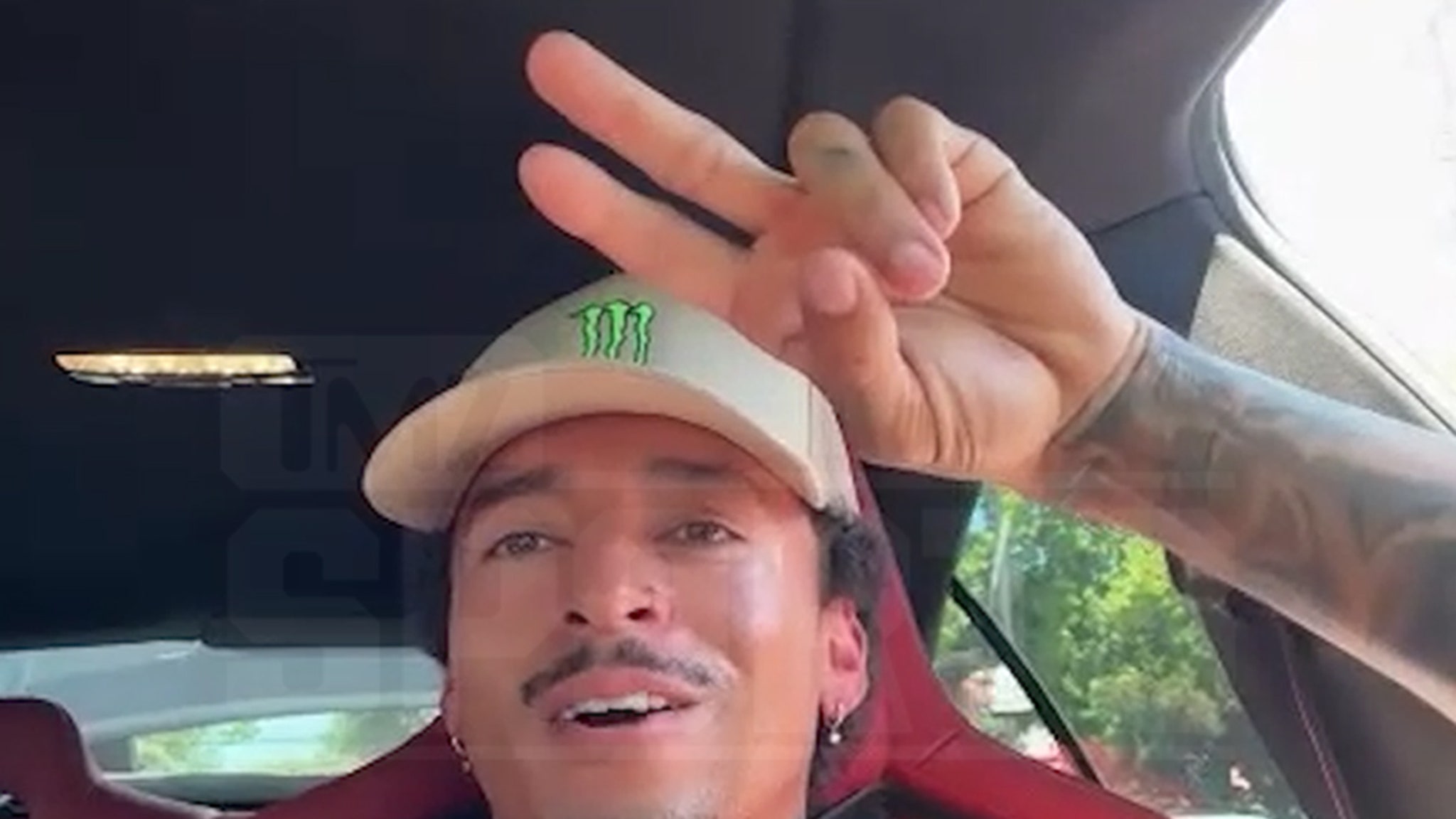
Nyjah Huston
MGK’s Hitting SLS
… ‘Special’ Performance Incoming!!!
Published
TMZSports.com
Those taking the PCH to catch Friday’s SLS better be prepared for Machine Gun Kelly — Nyjah Huston tells TMZ Sports he’s expecting MGK to perform a wild show at the Street League Skateboarding event!!
The competition officially kicks off at the Santa Monica Pier in just a few hours — at 1:30 PM PT, to be exact — and while most fans will come to watch Huston and other skaters throw down tricks … the Olympic bronze medalist told us they’re going to get a treat from MGK once they arrive as well.
Waiting for your permission to load the Instagram Media.
Huston said the “my ex’s best friend” crooner will belt out a few songs … before explaining to us, “I heard they actually have a whole, like, special way he’s going to perform.”
“I’m not going to give it away,” the star skater added, “but it sounds super sick.”

The entire event looks like it’ll be must-see, as Huston called the location a straight up “legendary skate spot.”
Plus, he told us he can’t wait to flip his board by the Pacific Ocean — considering as a California-native, it’s basically his backyard.

“It’s going to be a great vibe,” Huston told us. “I love that it’s a free event — just invite all the fans to come out and have a good time.”
“It’s going to be a sick one.”
-

 Culture1 week ago
Culture1 week agoBook Review: ‘Original Sin,’ by Jake Tapper and Alex Thompson
-

 Education1 week ago
Education1 week agoA $5 Billion Federal School Voucher Proposal Advances in Congress
-

 Education1 week ago
Education1 week agoVideo: Opinion | We Study Fascism, and We’re Leaving the U.S.
-

 News1 week ago
News1 week agoAs Harvard Battles Trump, Its President Will Take a 25% Pay Cut
-

 Technology1 week ago
Technology1 week agoLove, Death, and Robots keeps a good thing going in volume 4
-

 Technology1 week ago
Technology1 week agoMeta’s beef with the press flares at its antitrust trial
-

 News1 week ago
News1 week agoMenendez Brothers Resentenced to Life With Parole, Paving Way for Freedom
-

 Politics1 week ago
Politics1 week agoRepublicans say they're 'out of the loop' on Trump's $400M Qatari plane deal


